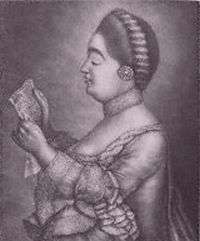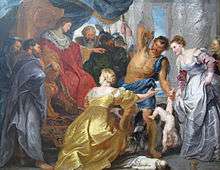Solomon (Handel)
Solomon, HWV 67, is an English oratorio by George Frideric Handel. The anonymous libretto - currently thought to have been penned by the poet/playwright Moses Mendes (d.1758)[1] - is based on the biblical stories of wise king Solomon from the First Book of Kings and the Second Book of Chronicles with additional material from Antiquities of the Jews by ancient historian Flavius Josephus. The music was composed between 5 May and 13 June, 1748 and the first performance took place on 17 March, 1749 with Caterina Galli in the title role at the Covent Garden Theatre in London where it had two further performances. Handel revived the work in 1759.[2]
The oratorio contains a short and lively instrumental passage for two oboes and strings in Act Three, known as "The Arrival of the Queen of Sheba", which has become famous outside the context of the complete work and was featured at the London Olympics in 2012.[3]
Background

The German-born Handel had been resident in London since 1712 and had there enjoyed great success as a composer of Italian operas. His opportunities to set English texts to music had at first been more limited; he had spent the years 1717 to 1719 as composer in residence to the wealthy Duke of Chandos where he had written church anthems and two stage works, Acis and Galatea and Esther; and had composed vocal music to English words for various royal occasions, including a set of Coronation anthems for George II in 1727, which had made a huge impact.[4] In 1731, a performance of the 1718 version of Esther, a work in English based on a Biblical drama by Jean Racine, was given in London without Handel's participation and had proved popular, so Handel revised the work and planned to present it at the theatre where his Italian operas were being presented. However the Bishop of London would not permit a drama based on a Biblical story to be acted out on the stage, and therefore Handel presented Esther in concert form, thus giving birth to the English oratorio.[5]:212 Such was the success of his oratorios in English that eventually Handel abandoned Italian opera, his last being Deidamia in 1741, and produced a string of masterpieces of oratorio in English.[6]
Opera seria, the form of Italian opera that Handel composed for London, focused overwhelmingly on solo arias and recitatives for the star singers and contained very little else; they did not feature separate choruses. With the English oratorios Handel had the opportunity to mix operatic arias in English for the soloists with large choruses of the type that he used in the Coronation anthems. The oratorios found a wider audience among more social classes than the aristocratic audience who had sponsored and enjoyed Handel's Italian operas.[7] "Solomon" was widely recognised by commentators of the day as a eulogy for Georgian England, with the just and wise King Solomon representing King George II and the mighty, prosperous kingdom of Israel reflecting the similarly happy state of England at the time of the work's premiere, in the view of its creators.[8]
Dramatis personae

| Role | Voice type | Premiere cast 17 March 1749 |
|---|---|---|
| Solomon | alto | Caterina Galli |
| Solomon's Queen | soprano | Giulia Frasi |
| Nicaule, Queen of Sheba | soprano | Giulia Frasi |
| First harlot | soprano | Giulia Frasi |
| Second harlot | mezzo-soprano | Sibilla Gronamann (Mrs Pinto) |
| Zadok, the High Priest[9] | tenor | Thomas Lowe |
| A Levite | bass | Henry Theodore Reinhold |
| Attendant | tenor | |
| Chorus of priests, chorus of Israelites[2] | ||
Synopsis

Act 1
The work begins with Solomon and his people celebrating the consecration of the Temple he has built in Jerusalem. Solomon rejoices in his married happiness to his one wife (unlike the biblical Solomon, who is stated to have had hundreds of wives and concubines),[10] and promises to build his queen a palace for her.[5] They express their love for each other and retire for the night as flower-scented breezes and nightingales' songs lull them to rest.[11]
Act 2
The wisdom of Solomon is presented in the famous biblical story of the two harlots who each claimed a single baby as her own. Solomon offers to solve the case by splitting the infant in half with his sword but the real mother rejects this solution and offers to hand the child over to the other woman, as Solomon knew the true parent would do.[10] The First Harlot and the chorus praise Solomon's judgement.[11]
Act 3
In Act Three we see a state visit from the Queen of Sheba to Solomon's kingdom. The king and his people entertain her with a musical masque of magnificent choruses depicting in turn the "lulling" sound of gentle music, the desire for military glory, the despair of an unhappy lover, and a storm which turns to calm.[5][11] All celebrate the Israel of the wise ruler Solomon as a Golden Age of peace, happiness, and prosperity.[10]
List of musical numbers
Act 3 begins with the very famous Sinfonia known as "The Arrival of the Queen of Sheba". (Note: "Sinfonia" in this context means a purely instrumental piece. "Accompagnato" is a recitative accompanied by the orchestra, rather than by continuo instruments only, as in the passages marked "recitative.")
|
|
|
 |
Arrival of the Queen of Sheba
performed by the Advent Chamber Orchestra with Humbert Lucarelli and Edino Biaggi on oboes. |
| Problems playing this file? See media help. | |
Musical features
"Solomon" is richly orchestrated by the standards of its day, calling for an orchestra of flutes, oboes, bassoons, horns, trumpets, timpani, strings, and continuo instruments. Many of the grand and varied choruses are in eight parts ("a double chorus") instead of the more usual four parts.[8] The final number of Act I is the chorus “May no rash intruder”, usually called the Nightingale Chorus, with flutes imitating birdsong over a gentle rustling effect created by strings divided into numerous different parts.[8] Act 3 begins with the very famous Sinfonia known as "The Arrival of the Queen of Sheba", a bright and sprightly orchestral piece featuring oboes which has often been used outside the context of the oratorios as a processional piece.[3] (Sir Thomas Beecham is believed to have given the name, "The Arrival of the Queen of Sheba," to this sinfonia, perhaps in 1933, when he made a recording of it, or perhaps in 1955, when he recorded the entire oratorio.)
Recordings
In popular culture
In season one of the BBC One series Last Tango in Halifax, it is mentioned in several episodes that Celia Dawson has chosen "The Arrival of the Queen of Sheba" to announce her entrance at her wedding to Alan Buttershaw.[12] Many brides request the piece as their entrance or exit music.
Notes
- ↑ Andrew Pink. ‘Solomon, Susanna and Moses : locating Handel's anonymous librettist’. Eighteenth Century Music. Volume 12 / Issue 02 (September 2015) pp. 211-222.; accessed 6 April 2016
- 1 2 "G. F. Handel's Compositions". The Handel Institute. Retrieved 28 September 2013.
- 1 2 Schwarm, Betsy. "The Arrival of the Queen of Sheba". Britannica.com. Retrieved 28 April 2014.
- ↑ Kemp, Lindsay. "Programme Notes for Saul" (PDF). BBC. Retrieved 28 September 2013.
- 1 2 3 Burrows, Donald (2012). Handel (Master Musicians Series). Oxford University Press, USA; 2 edition. ISBN 978-0-19-973736-9.
- ↑ Hicks, Anthony (2013), "Handel, George Frideric", Grove Music Online, Oxford University Press (subscription required)
- ↑ Martini, Joachim C. "Programme notes for "Solomon"". Naxos. Retrieved 29 April 2014.
- 1 2 3 Lang, Paul Henry (2011). George Frideric Handel (reprint ed.). Dover Books on Music. ISBN 978-0-486-29227-4.
- ↑ Zadok the Priest, HWV 258, is also the title of one of four Coronation Anthems written by Handel for the coronation of George II of Great Britain but apart from its name, the work is unconnected with the Solomon oratorio.
- 1 2 3 Woodstra, Chris (September 1, 2005). All Music Guide to Classical Music: The Definitive Guide to Classical Music (All Music Guides). Backbeat Books. ISBN 0879308656.
- 1 2 3 Knapp, J. Merrill. "Programme notes for "Solomon"". Opera Today. Retrieved 28 April 2014.
- ↑ "Last Tango in Halifax season 1, episode quotes and synopses". Sharetv.
External links
- Libretto at Stanford University
- Solomon: Scores at the International Music Score Library Project
- Score, Deutsche Händelgesellschaft (German Handel Society), 1867
